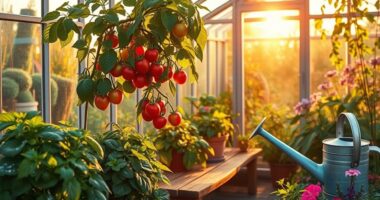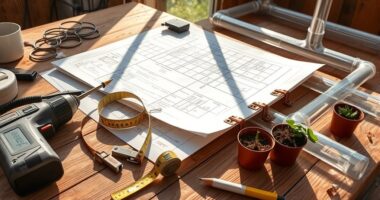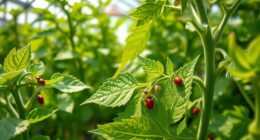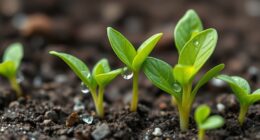Exploring cold frames and mini greenhouses shows you how these structures extend your gardening season, protect plants from frost, wind, and rain, and create a warm microclimate for seedlings. They are cost-effective, energy-efficient tools that maximize crop yields and allow more control over plant environments. With simple designs and added insulation, you can start plants early and harvest later. Keep exploring to discover tips that will help you optimize these helpful gardening aids.
Key Takeaways
- Cold frames and mini greenhouses extend growing seasons by protecting plants from frost and harsh weather conditions.
- Their structures create controlled microclimates suitable for seedlings and tender crops.
- These structures are energy-efficient, relying mainly on sunlight, with options for insulation and supplementary heat.
- They are cost-effective, easy to manage, and can include automation features like ventilation and watering systems.
- Proper use maximizes crop yield, enhances plant health, and allows for early planting and late harvesting.
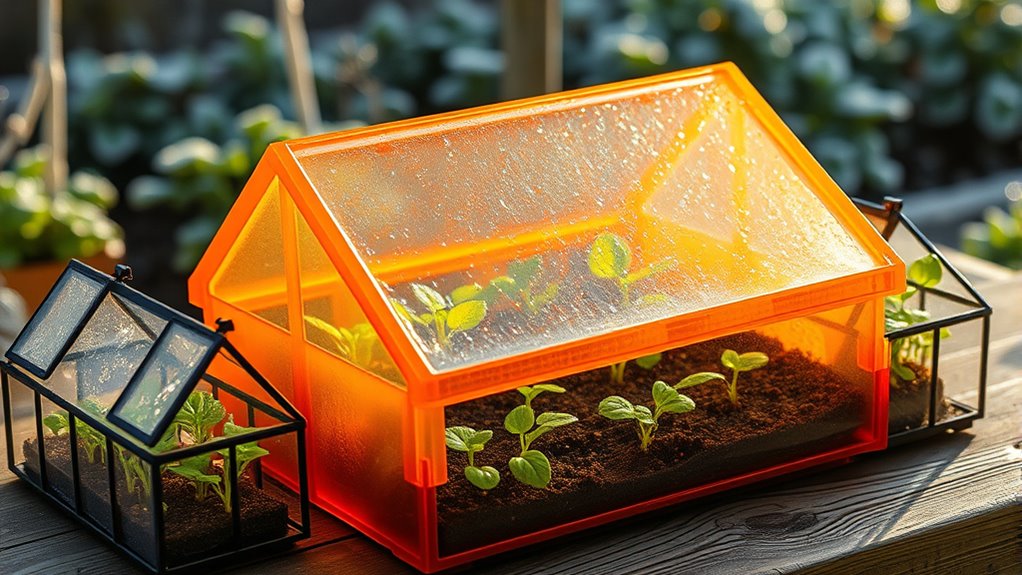
If you’re looking to extend your growing season or protect delicate plants, cold frames and mini greenhouses are excellent solutions. These structures allow you to start planting earlier in spring and continue harvesting later in fall, giving you more control over your garden’s productivity. With proper use, they serve as effective tools for season extension and crop protection, helping you manage temperature fluctuations and shield plants from harsh weather. Cold frames are typically low, box-like enclosures with transparent lids or walls that trap heat from the sun, creating a microclimate perfect for seedlings or tender plants. Mini greenhouses, on the other hand, are more versatile structures, often larger and equipped with ventilation systems or adjustable panels. Both options enable you to create a conducive environment for your plants, regardless of outside weather conditions.
Using these structures, you can start seedlings indoors and transplant them into your cold frame or mini greenhouse when they’re strong enough, thereby gaining several extra weeks of growth before outdoor conditions become ideal. This early start not only boosts your crops’ overall yield but also extends the period you can enjoy fresh produce. During colder months, they act as a barrier against frost, wind, and rain, considerably reducing the risk of crop damage. In this way, you maximize crop protection and ensure your plants stay healthy through unpredictable weather patterns.
Start seedlings early indoors to extend your growing season and protect plants during cold months.
Another benefit of cold frames and mini greenhouses is their energy efficiency. Since they rely on sunlight and natural heat, they don’t require much power, making them an eco-friendly choice for sustainable gardening. You can enhance their effectiveness by adding insulation or supplementary heat sources for particularly cold nights. Their small size makes them easy to manage, clean, and customize, allowing you to tailor the environment precisely to your plant’s needs. Whether you’re growing vegetables, herbs, or flowers, these structures give you more control over growing conditions, reducing the reliance on chemical interventions or synthetic heating.
In addition, cold frames and mini greenhouses are cost-effective investments that can pay for themselves over time. They help you produce more food at home, save money on store-bought produce, and provide a rewarding gardening experience. With a bit of planning, you can even automate ventilation or watering systems, making crop protection and season extension more efficient. Furthermore, the proper use of ventilation systems can help regulate temperature and humidity, optimizing plant growth. Overall, these structures empower you to make the most of your garden year-round, turning a small space into a productive, protected environment for your plants to thrive.
Frequently Asked Questions
How Do I Choose the Best Location for My Cold Frame?
You should choose a location that’s sheltered from wind and avoids shade. Place your cold frame where it gets plenty of sunlight during the day, ideally facing south for maximum warmth. Make certain it’s on well-drained soil to prevent waterlogging. Keep it close to your garden tools and water source for convenience. By selecting a sunny, protected spot, you’ll create a perfect environment for your plants to thrive.
What Materials Are Most Durable for Mini Greenhouses?
You’ll find that durable materials like polycarbonate and thick polyethene are the best for mini greenhouses because they offer excellent weather resistance. Polycarbonate, in particular, is highly impact-resistant and can withstand harsh weather, making it a reliable choice. While glass looks great, it’s more prone to breaking. Always choose materials that balance durability and weather resistance to make certain your mini greenhouse lasts through seasons.
Can Cold Frames Extend My Growing Season in Winter?
Yes, cold frames can extend your growing season in winter. You should choose hardy plants suited for colder weather and consider insulation options like straw or bubble wrap to boost warmth. Proper plant selection and insulation help maintain consistent temperatures inside the cold frame, protecting your crops from harsh conditions. By doing this, you’ll enjoy fresh produce longer and maximize your gardening efforts even during winter months.
How Do I Control Humidity Inside a Mini Greenhouse?
To control humidity inside your mini greenhouse, you should use proper ventilation strategies like adjustable vents or small fans to promote airflow. Additionally, humidity monitoring tools help you keep track of moisture levels, so you can adjust ventilation accordingly. If humidity gets too high, open vents or add a small fan; if it’s too low, consider misting or using a humidifier. Regular monitoring keeps conditions ideal for your plants.
Are There Specific Plants That Thrive Better in Cold Frames?
Imagine plants bursting through the cold like warriors defying winter’s grasp! Certain plants, like lettuce, spinach, and herbs, thrive in cold frames because of their high plant compatibility and ability to handle seasonal adjustments. These plants love the cool, protected environment, giving you fresh harvests even when outside temperatures plummet. By choosing hardy, cool-loving varieties, you’ll maximize your cold frame’s potential and keep your garden thriving year-round.
Conclusion
By using cold frames and mini greenhouses, you can extend your growing season by up to 8 weeks, giving you more fresh produce and flowers. These simple structures protect your plants from harsh weather and pests, boosting your gardening success. Did you know that over 60% of home gardeners report improved plant growth with mini greenhouses? Embrace these tools, and you’ll enjoy healthier plants and a more rewarding gardening experience all year round.


